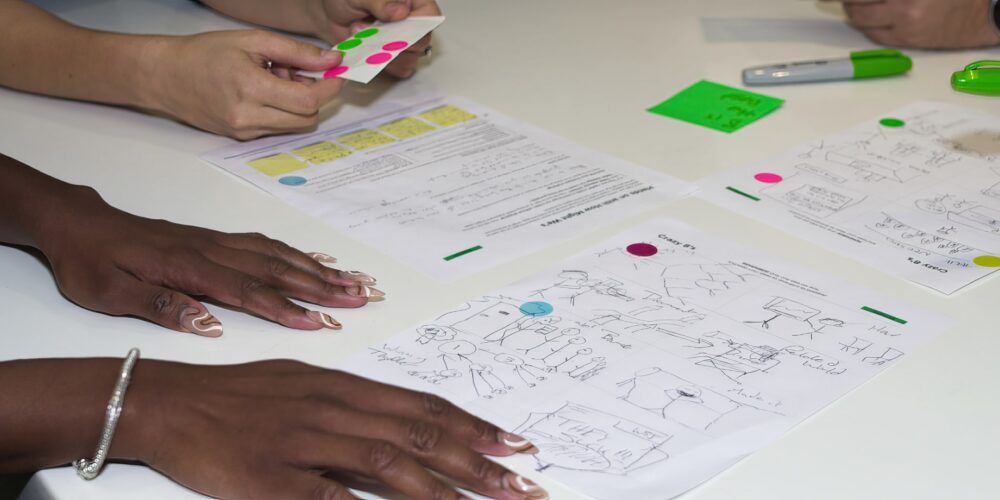
When a Design Sprint isn’t for you
At Three Five Two, we love a great design sprint. The opportunity to get deep into a problem and pivot quickly and creatively is music to our ears.
But I’m here to tell you that a design sprint might not be the right solution for you.
You’ve probably heard the term design sprint thrown around a lot: ever since Google Ventures published its fast-paced validation process in 2010, it’s been on the tip of every innovator’s (or wannabee innovator’s) tongue. It’s become synonymous with other powerful ideas like rapid ideation and design thinking—and rightfully so: the framework has been shaking things up across thousands of companies, and is used today in digital and physical services alike.
If you haven’t been privy to one, you might not understand why it’s such a popular concept. A design sprint is a turbo-charged workshop and prototyping process that gets your team from idea to validation in five days. You dive deep into the problem, sketch out potential solutions, pick the one that has the best potential to solve the problem, make a prototype, and then take it for a spin with some real-life target customers. By the end, you’ll evaluate desirability, know if there’s a market fit, and understand how well users grasp the concept. It’s a winner because it’s quick, won’t break the bank, it’s all about teamwork, and it puts your users front and center. At the same time, it’s a secret weapon to get your team all on the same page, pronto.
There are times when a design sprint is right for your needs (psst, we made a handy checklist to help you know!). And when that happens, the work that’s done in just one week is :chef’s kiss:. If you’ve been in a design sprint, you know what I mean. The magic of focused collaboration of a diverse set of minds, with users front and center, is truly a thing of beauty. It’s like a retreat, an amazing brainstorming session, and a powerful learning experience all rolled into one.
Did I just sell you on it? Well, pump the brakes, because there are plenty of times when a design sprint won’t work for your project or company. Before you go all-in, know that they aren’t a one-size-fits-all solution. You have to be smart about when and how to invest in it in order to realize the benefits. Problem definition, company culture and hierarchy, and so much more affect the ability for you to leverage design sprints effectively.
Reasons to not do a design sprint can range from deeply seeded issues within your organization to superficial hurdles that can easily be resolved with a round of research or a meeting. Even if you know that your team or product would benefit from a design sprint, keep these obstacles in mind so you can beef up your defensive line and support your team through the sprinting process.
Let’s dig a little deeper into when the answer isn’t design sprints:
- You’ve Got a Small, Simple Problem: Ha, don’t we all wish we had small, simple problems? But sometimes that really is the case—and if your problem is straightforward, you might not need a design sprint. Figuring out what a button should be labeled on your homepage doesn’t need a week of a team’s time. No need for a full-blown brainstorming session.
- Your Scope is Too Wide: On the opposite end of the spectrum, if your problem’s so broadly defined that it encompasses a myriad of issues across a wide range of users or products, a design sprint won’t cut it. If you don’t narrow down the problem definition, solutions are spread to thin across the space and you’ll end up chasing your tail. Take a step back and define your problem clearly before you jump to a design sprint.
- You’re Stymied by Bureaucracy and Regulations: Navigating internal politics and red tape can kill your momentum. Not only does it slow down sprint progress, it also makes it harder to put the learnings you gain from your sprint into action.
It’s a pretty common misconception that decision-makers don’t need to participate in the design sprint process, but their participation is a key to cutting through the red tape. By staying close to the work, they can better contextualize the learnings and recommendations, which means they can champion the next steps and give meaningful momentum to the project. But, if you can’t get the buy-in you need, your work may end up stilted or halted by bureaucracy, affecting not only your team’s morale, but also your product’s success.
- Your Organization is Resistant to Change: Some organizations are slow to adopt change, which makes it pretty hard to incorporate the rapid validation goodness of a design sprint. The design sprint is like an Instapot of innovation – you’ll cook twice as fast, and if you aren’t ready for dinner to be served when it’s all done, then you may end up eating a cold meal later. Organizations need to be ready to adopt new solutions coming out of design sprints and implement them quickly to ensure they don’t become stale or, even worse, outdated as the target demographic’s needs change. If your company isn’t ready to move quickly, dinner’s gonna be served too late. And no one likes cold meatloaf.
- Your Culture Fosters a Fear of Failure: Don’t be afraid to fail; that’s how you learn. Failure is the best part of experimentation and is how we learn what isn’t going to work. Unfortunately, some companies are so focused on taking the right next step (for profits, stakeholder approval, etc) that they aren’t willing to ever fail, even if they learn in the process.
The heart of a design sprint is making educated decisions, testing them out, and seeing if they hit the mark. If your team is uncomfortable with failing, even in a closed environment, then a design sprint simply won’t work without some deep coaching (and maybe even culture shifts) ahead of time.
- You’re Battling Tight Time Budgets: One of the appeals of a design sprint is that it’s a small investment that can save you big dollars in the long run, but they do take a concerted investment of time up front. You’ll need experts from all corners of your organization to join throughout the five days to provide their expertise and unique perspectives. Time demands or competing priorities can make it difficult to commit the resources you need. Be sure to lay a strong foundation of buy-in from your team and your leadership before you begin the work.
- There’s Significant Research Needed: Sometimes, you just don’t have enough info about your audience, their pain points, or where to start amongst a variety of challenges. In cases where the needed research is much more involved than what can be done in a sprint-like timeframe, starting with generative research is the right next move. By taking the time to better understand the problem space, you ensure you can move quickly and confidently into your design sprint.
- Testing is Not Possible: Sure, design sprints can be a great place to explore new ideas, but if you’re not taking the time to test and validate your solutions, you’re just acting on hunches, and you’re gambling with your product’s, your team’s, and your success. Ensure you can dedicate time and resources to verify if your solutions hit the mark before signing on for a sprint.
And those are ten reasons to rethink if you’re ready for design sprints! What’s that? That was only eight?
OK, so those are the eight reasons to rethink if you’re ready for design sprints!
Plus, here’s two bonus watchouts! They’re not dealbreakers, but they’re absolutely worth noting as you prepare for your first design sprint.
- You’re Rushing Creativity: You want solid ideas, so you can’t rush the brainstorming process. If your team can’t dedicate the time to participate in true divergent thinking, or they feel pressured to make decisions without exploring diverse ideas, you could end up with a quick but misguided solution. In moments like these, you have to slow down in order to speed up.
- Your Teams Have Zoom Fatigue: Successful remote collaboration has increasingly become more and more attainable, but it’s not perfect by any means. Zoom fatigue is real, and distractions are easy to come by. Doing a remote design sprint takes special care and execution and a team willing to do the work to stay focused. So, if you’re doing a remote design sprint, make sure your crew can lock in and keep their eyes on the prize.
It’s also a great idea to find a partner who already knows how to facilitate remote design sprints to keep users engaged and creative thinking high (ahem, hi there).
Design sprints are your secret weapon—when you use them right. But it can be easy to overuse or rely on them in the wrong situations, and then lose faith in their power when you no longer get the outcomes you were looking for. To rock the design sprint game, you need the right-sized problem, the time and budget to validate, and a culture that embraces the ability to turn failures into learnings. Some of these characteristics are easy to achieve with clear communication and buy-in, while others might take a little more finesse.
You don’t have to have a perfectly smooth path laid out, but knowing where you might trip up means you can find a way to avoid a toe-stub along your innovation journey. (And if you’re looking for someone to help you come up with ways to overcome these hurdles, you know where to find us.) Now go forth, armed with this knowledge, and design sprint with care!




